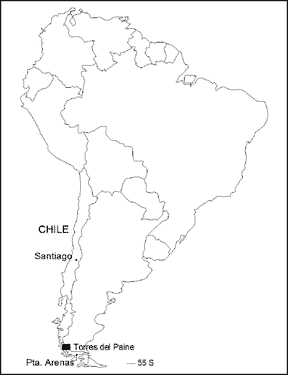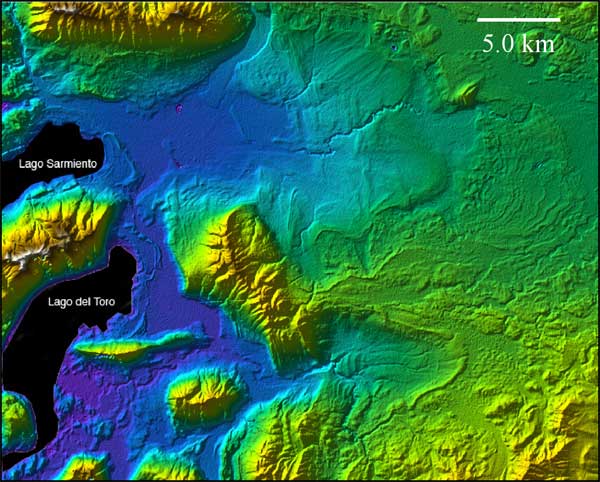The last glaciation and climate change in
Patagonia Occidental, Chile
Juan Luis García, MS Candidate,
Climate Change Institute, University of Maine
Research Problem and Objectives
The timing and nature of the last glacial maximum (LGM) and termination in the Southern Hemisphere remain unclear but are important for addressing major problems, such as the origin of the ice ages and the cause of abrupt climate change. One important question concerns the possible existence of interhemispheric asynchrony of past climate change. For example, ice core records show that the last deglaciation (Termination I) apparently occurred several thousand years earlier in Antarctica than it did in Greenland. Other climate events, such as the Younger Dryas (YD) and the Antarctic Cold Reversal (ACR), also seem to be out of phase. In the southern mid-latitudes, scattered records from terrestrial and oceanic sites do not show any clear trend; some show correspondence with the North Hemisphere (NH) climate fluctuations, but others illustrate the antiphased Antarctic climate pattern. Identification of interhemispheric relationships will lead to a better understanding of the role of the Southern Hemisphere (SH) in abrupt climate changes that characterize the glacial-interglacial cycles. In addition, greater knowledge of the phasing of climate changes will help determine the manner in which forcing mechanisms (atmospheric/oceanographic/external control) affect climate changes on Earth.

Park in Southern South America
Improvingthe paleoclimate record of the SH is prerequisite to understanding the causeof ice ages. Milankovitch theory, the most widely accepted model of ice ages,focuses on NH insolation. Yet, because of the earth’s precession, conditionsapparently favorable for ice ages are out of phase between the polar hemispheres.Despite this fact, existing SH records seem to suggest that both hemispheresentered the LGM at approximately the same time. For example, glaciers in bothhemispheres reached their maxima between roughly 20-30 ka BP. Either there issome mechanism (yet unknown) that translates the NH insolation signal to theSH or our current understanding of Milankovitch theory is flawed. Recently, Huybersand Wunsch (2005) argued that precession plays little, if any role, in ice agesas the intensity of precession is offset by its duration. Specifically, whensummer insolation due to precession is most intense, the summers are shorter,so that overall degree-days (or other measurements of temperature) remain constant.Huybers and Wunsch refocused attention on obliquity which, being the same inboth hemispheres, could account for synchronous climate changes. In order todetermine the exact phasing of the hemispheres on orbital timescales, it is necessaryto determine the precise timing and extent of major cold phases in the southernhemisphere, and to compare them with NH chronologies.
My proposedresearch will answer important questions regarding the initiation, extent, duration,and termination of the LGM in Patagonia Occidental, Southern Chile (50º S:Fig. 1). This vital mid-latitude region is on the opposite side of the globefrom 65ºN, the latitude used by Milankovitch, as well as from the NorthAtlantic, which is thought to be a key player for abrupt climate change. Isolatedfrom any major mechanism controlling NH climate, Patagonia Occidental shouldprovide a clear record of Late Pleistocene climate change in the SH, and so describemainly the effect of SH and external climate forcing mechanisms. Furthermore,comparison of this data to Antarctic records will highlight any prominent climatefeatures, such as the early Termination or the late-glacial Antarctic Cold Reversal.
PatagoniaOccidental maintains active glaciers flowing from the South Patagonian Icefield(48º-50º S). During the LGM and earlier glaciations, these large outletglaciers advanced through the Andes and left a strong imprint on the surroundingtopography. Preservation of glacial deposits from the LGM and many earlier glaciationsis excellent. Moreover, the location of Patagonia means that, for a couple ofreasons, it has great potential for climate-change research. First, the regionoccupies an isolated and unique geographic position- no other land mass existsat these latitudes. Second, Patagonia occurs in a sensitive climatic zone dominatedby the prevailing Southern Westerlies. The Southern Westerlies are the principlesource of moisture in Patagonia and correlate strongly with the regional precipitationpatterns and glacier-accumulation rates. In fact, fluctuations in the positionand intensity of the Westerlies have been linked with local glacier fluctuation.For example, northward migration of the westerly belt is believed to correlatewith relatively humid cold phases and glacier advance in Patagonia. The positionof the Westerlies is maintained to the north by the Subtropical Pacific Anticycloneand to the south by the Polar front. By obtaining glacial records along a latitudinaltransect, I plan to reconstruct Late-Pleistocene variation in the position ofthe westerly belt and its influence on the Patagonian climate. Additionally,I plan to compare my results to palynological record from this area reconstructedby Dr. Patricio Moreno This multiproxy approach will enable valuable cross-checkingof the data-set and validation of the Patagonian glacier record.

Figure 2: Digital Elevation Model (DEM) of the study area, illustrating well-defined moraine ridges and geomorphological attributes of the Sarmiento and del Toro lake basins in Torres del Paine National Park.
One main issueis that the SH constitutes a predominantly maritime climate that is influenceddirectly by ocean dynamics. Ocean is a huge medium to transport heat from lowto high latitudes, and so it make possible a direct, although not instantaneous,connection between hemispheres. This is an important aspect to consider whencomparing (1) the timing of climate phases and (2) the thermal fluctuations betweenterrestrial and oceanic sites both in the SH, and between the NH and SH.
The developmentof more refined and robust chronologies and the quantitative reconstruction ofpast climate conditions are basic requirements to test hypotheses regarding asymmetric/symmetricinterhemispheric climate fluctuations (Turney et al, 2006) and to date preciselythe timing of the LGM and Termination I precisely. This project seeks to improvethe currently immature paleoclimate chronology of Patagonia Occidental, and toprovide information both on former climate controls in the region and on inter-hemisphericclimate relationships.
I will approachthese problems through a glacial geologic and geochronologic study of two lakebasins containing moraine sequences in Torres del Paine National Park: Lago Sarmientoand Lago del Toro (Figure 1 & 2). Both basins were scoured by glacier lobesflowing from the Patagonian Icefield during the last glaciation. Satellite imageryand aerial photographs show a conspicuous glacier landscape and well-definedend-moraine sequences with great potential for reconstruction of climate duringthe last glaciation. I will use these to produce a preliminary geomorphologicalmap prior to the fieldwork. In the field, I will complete detailed mapping througha combination of photo analysis and ground coverage on foot and by car. To producea robust chronology, I plan to use both surface-exposure and radiocarbon methodsto accurately date moraines and other glacial features. Surface-exposure agedating has shown to be most precise in temperate latitudes where glacial erosionwas sufficient to remove previous exposure. Wherever possible I will collectsamples for radiocarbon dating so as to cross-check my surface-exposure chronology.
Little previouswork exists for the Torres del Paine region (Caldenius, 1932; Marden and Clapperton,1995; Marden, 1997; Fogwill and Kubik, 2005), resulting in a limited late glacialchronology and virtually no information for the LGM or termination. Marden (1995)recognized two glacier advances after the last termination, one of them occurringduring the Younger Dryas chronophase, in response to a wetter (southward shiftof Westerlies) and slightly cooler climate in Patagonia. In contrast, Fogwilland Kubik (2005) related a prominent glacier advance with the Antarctic ColdReversal, suggesting that the glaciers in Patagonia were out of phase with theNorthern Hemisphere. This project will test those results, as well as documentthe virtually unexplored Late-Pleistocene glacial stratigraphy of Patagonia Occidental.
Field Tasks and Schedule
The field season will take place during March-April (2007), with a total of six weeks of fieldwork in Torres del Paine. Main activities included in the field program are:
- Geological mapping. I will develop a detailed map of the main stratigraphic sections and landforms included in the study area. I will use a digital elevation model, aerial photographs and topographic maps (1:50.000) of the study area as a base map. This map will allow me to identify and separate distinct phases of glacial advance and retreat. It will also provide the basis for my chronologic work.
- Sampling. I will use surface-exposure and radiocarbon methods to date glacier expansion. Rock samples will be taken from the most prominent moraine ridges in front of the Sarmiento and Del Toro lakes. I expect to collect approximately 70 surface-exposure samples in order to have sufficient dates for key moraines. Our previous work has shown at least six dates are required for each moraine in order to obtain a robust age. Preliminary work in the region by Dr. Michael Kaplan, a collaborator on this project, has shown that sufficient boulders of suitable lithologies (granite, granodiorite) exist on the moraines. Organic material, if present, will be sampled from stratigraphic sections geographically associated with moraine ridges or other key landforms. Data obtained from both techniques will complement each other and reinforce the results achieved in this work.
The geological approach of this project will lead to (1) an improvement of the current climate chronology and to (2) high valuable progress in our understanding of the origin of ice ages and abrupt climate changes.
References
Caldenius, C.M., 1932: Las glaciaciones cuaternarias en la Patagonia y Tierra del Fuego. Geografiska Annaler, 14: 1–164.
Fogler C.J. and Kubik P.W. 2005: A glacial stage spanning the Antarctic cold reversal in Torres del Paine (51°s), Chile, based on preliminary cosmogenic exposure ages. Geografiska Annaler 87 A (2): 403-408.
Huybers, P. and Wunsch, C. 2005: Obliquity pacing of the late Pleistocene glacial terminations. Nature vol. 434, p. 491-494
Marden, C.J., 1993: Late Quaternary glacial history of the South Patagonian Icefield at Torres del Paine, Chile. PhD thesis. University of Aberdeen. 298 p.
Marden, C.J., 1997: Late-glacial fluctuations of the South Patagonian Icefield, Torres del Paine National Park, Southern Chile. Quaternary International, 38/39: 61- 68.
Marden, C.J. and Clapperton, C.M., 1995: Fluctuations of the South Patagonian Icefield duringthe last glaciation and the Holocene. Journal of Quaternary Science, 10: 197–210.
Turney, Chris S.M., Kershaw, A. P, Lowe, J.J., van der Kaars, Johnston S, Rule, S., P. Moss, Lynda Radke, John Tibby, Matt S. McGlone, Janet M. Wilmshurst, Vandergoes, M. J., Fitzsimons, S.J., Bryant, C., James, S., Branch, N. P., Cowley, J., Kalin R. M., Ogle N., Jacobsen, G.,. Fifield, L. K., 2006: Climatic variability in the southwest Pacific during the Last Termination (20–10 kyr BP). Quaternary Science Reviews 25: 886–903
